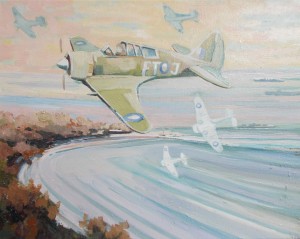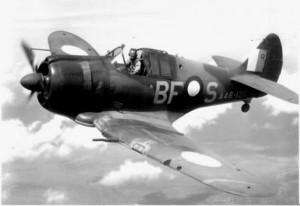Dear reader what follows is a particularly silly description from Australia’s glorious manufacturing history. And what better personification of ‘Can-do’ than the CAC Boomerang. Designed and ready within fifteen weeks. Demonstration than when put to the test Australia could really be innovative and forward thinking. Now we squabble over energy policy whilst the world literally burns. Still though the Liberal Party has seen the light and thrown it’s weight behind One Nation in W.A.
A decision guided by a shared interest in strong governance and principle to keep the status quo intact. And do nothing about the future which is a whole election away.
 This illustration depicts the glorious moment when 422 Squadron “Wignell’s own Wings”, performed their ceremonial fly past over Black Rock on the 23rd September 1944. The Boomerang, originally designed as high speed interceptor in 1942 was outclassed by 44 by the Spitfires, Mustangs and Corsairs then in use in the Pacific Theatre. However as a close support aircraft and close attack interceptor its agility was highly valued, The Boomerang could get into tricky spots and out again. As the Pilot Bluey-Bouncer-Booma , the famous red headed fighter ace enthused “ it’ll do the job once , twice, three times and all day long and always get you back again’.
This illustration depicts the glorious moment when 422 Squadron “Wignell’s own Wings”, performed their ceremonial fly past over Black Rock on the 23rd September 1944. The Boomerang, originally designed as high speed interceptor in 1942 was outclassed by 44 by the Spitfires, Mustangs and Corsairs then in use in the Pacific Theatre. However as a close support aircraft and close attack interceptor its agility was highly valued, The Boomerang could get into tricky spots and out again. As the Pilot Bluey-Bouncer-Booma , the famous red headed fighter ace enthused “ it’ll do the job once , twice, three times and all day long and always get you back again’.
 Such was the performance of the legendary Boomerang that a flight of Boomerangs en route to Sydney found themselves flying via Hobart in a complete circle due to faulty Astro Navigational compass. The Boomerangs almost drained of fuel returned to Point Cook. Their reliability was well and truly proven. As a close support aircraft they were famous for their penetrating work upon Shaggy Ridge, the Pimple and the Krause’s Knob in the prelude to the Finschafen campaign. In one instance, a flight of Boomerangs armed with two underslung Mk V anti personnel mines were able to subdue an impregnable japanese dugout by landing the charges at precisely the right spot an at precisely the exact moment when the commander of the japanese Northern New Guinea was having his bath. The resultant explosion, sent the bath flying in a parabolic arc which sank the adjacent destroyer Fukiyaki in a sheet of flame and smoke, to which the commander enthused, bombed, bathed and bust in one hit. ‘A clean sweep’.
Such was the performance of the legendary Boomerang that a flight of Boomerangs en route to Sydney found themselves flying via Hobart in a complete circle due to faulty Astro Navigational compass. The Boomerangs almost drained of fuel returned to Point Cook. Their reliability was well and truly proven. As a close support aircraft they were famous for their penetrating work upon Shaggy Ridge, the Pimple and the Krause’s Knob in the prelude to the Finschafen campaign. In one instance, a flight of Boomerangs armed with two underslung Mk V anti personnel mines were able to subdue an impregnable japanese dugout by landing the charges at precisely the right spot an at precisely the exact moment when the commander of the japanese Northern New Guinea was having his bath. The resultant explosion, sent the bath flying in a parabolic arc which sank the adjacent destroyer Fukiyaki in a sheet of flame and smoke, to which the commander enthused, bombed, bathed and bust in one hit. ‘A clean sweep’.
However in spite of the glory, during the closing stages of the war, the allied high command were still gravely concerned about groups of japanese infantry that still held out in isolated outposts across the pacific. Unable to spare the resources for mopping up exercises and unwilling to sacrifice so many lives at the end of the war which was to all intents and purposes won, they set about developing a modified anti personnel mine which could be dropped at almost ground level, and the resultant shock-wave, when detonated, would render all individuals within a twelve kilometre radius insensible. The bomb, nicknamed the “Sleep-maker’, resembled a torpedo. The armourers had a splendid time painting moons, cows, and all manner of sleep related images. But after a two day period the victims would recover, enabling a peaceful rounding up and surrender. Initial trials on paddocks filled with sheep and open range chicken farms had proved promising. In one instance a flight of Boomerangs operating out of Canberra inadvertently dropped one on parliament and no one noticed for several weeks.
Finally a date was slated for the operation on the island of Teri-Yaki part of the Itchy- na na chain, in which a large garrison of Japanese had refused any entreaty to surrender. A flight of twelve Boomerangs were readied for attack and under cover of night their escort carrier, (seen in the background) HMAS Prolapse. At first the attack seemed to be an outstanding success, the Boomerangs all taking off in perfect formation and then headed directly towards their designated target. Just before they arrived over the target, the Boomerangs in perfect formation turned southwards and headed back towards their escort ship. In a matter of minutes it was all over. The escort and the Boomerangs were engulfed in a titanic explosion and slid to the bottom of the Ichi-waki sea. The subsequent enquiry revealed the astro navigational compass had not been re-calibrated to the Northern hemisphere and subsequently their “return instinct” counteracted the pilots course. The rest of the squadron were scrapped, and the Boomerangs retired from active service.

